Every Person Has a Right to Health
My mother, Azucena Escoto, lived a life typical of women in Nicaragua’s impoverished rural communities. Married and a mother at the age of 16, she became the sole provider for her young family of seven children when my father left us just ten years later.
The town I grew up in, Mina El Limon, is built around a gold mine. The people who own the mine are wealthy, but like most of the people in the village, my mother earned less than $1 a day. Determined to give her children a chance to rise above a life of poverty, Azucena looked for work outside of our village and took a job in the capital city of Managua. The city is a three-hour bus ride from Mina El Limon, so Azucena decided to leave us in the care of my grandma while she worked in the city. My mom returned home for a couple of days every month - proudly handing over her monthly salary of $160.
Even though I was just a baby when she left and my life in Mina El Limon was easier because of Azucena’s hard work - I never stopped missing her. I was always planning for the day she would be back for good, and my dreams were filled with all of the things we would do together – just like other girls. In late 2006, when I turned 16, my mom finally returned home. However, it was not the joyful reunion we expected. Azucena was stricken by sudden weight loss and severe pain. Too weak to continue working, she finally made her way to a hospital where she learned she had cervical cancer. According to the diagnosis, the cancer was advanced, and she would have about a year left to live.
Azucena, realizing her family depended on her for survival, convinced the doctor to admit her to the country’s one public hospital that treats women with cervical cancer. As I was going through high school, I experienced her suffering as she struggled through painful episodes of chemotherapy. Now my dreams revolved around miracle treatments that would make her healthy again. Azucena returned to work but continued to decline and eventually was fired from her job. She went back to the hospital for another diagnosis and found out cancer had invaded her colon and stomach. Despite the immense courage Azucena showed in the face of the disease, she lost her battle to cervical cancer and died at the young age of 48 - just weeks before I graduated from high school.
After watching her torturous battle and death from cervical cancer, I began to dream about finding a way to keep more children from losing their mothers to this horrible disease. I earned a scholarship to the university determined to learn everything I could about cervical cancer and in 2013 graduated with a degree in clinical bioanalysis focused on epidemiology. Cervical cancer is a slow-growing cancer caused by HPV, the most common sexually transmitted infection. In the United States and other developed countries pre-cancerous cells are detected by PAP tests and easily treated. Death from cervical cancer is one of the greatest health inequities in the world - with 85% of deaths occurring in developing countries, which lack access to the most basic proactive health measures for women.
As I shared the knowledge that cervical cancer, a preventable disease, is the #1 cancer killer and a leading cause of death of women in Nicaragua, it was easy to enlist others to make this dream a reality. We launched The Lily Project in 2014, motivated by a simple belief: every person has a right to health. Named in honor of Azucena, Lily in English, we deploy a simple ‘screen and treat’ procedure endorsed by the WHO for low resource countries. The procedure is beautiful in its simplicity: a trained health technician swabs a women’s cervix with vinegar (acetic acid); infected cells, if any, become white, and cryotherapy is performed to freeze and destroy the abnormal tissue. Since the beginning of the year, we have worked in rural villages in Nicaragua, similar to where I grew up, screening over 600 women and providing life-saving treatment to 60 who had precancerous cells. Dreams have turned into plans and with the help of the Friends of Lily, by 2020 The Lily Project will prevent cervical cancer for more than 200,000 impoverished women living in rural villages throughout Central America.
Today we are in a capital-raising campaign to purchase trucks and equipment to outfit our version of a mobile health clinic. To learn more and donate to our campaign, please visit: http://www.thelilyproject.org/get-involved.html.
About the blogger:
Anielka is the founder of The Lily Project. Her experience growing up in rural Nicaragua serves as the foundation for the vision of the project. Beating all odds, Anielka was accepted to the Autonomous University of Nicaragua-Leon (UNAN), where she studied bioanalysis with a focus on cytology. During an internship with the foremost trainer in Nicaragua of VIA and cryotherapy, Dr. Sonia Cabeza, she was fully trained on the use of visualization and cryotherapy. Visualization and cryotherapy are the most effective tools for early detection and treatment of HPV, the leading cause of cervical cancer. Anielka is now responsible for the overall development of the strategy and delivery of the detection and treatment to the rural communities in Nicaragua.




























